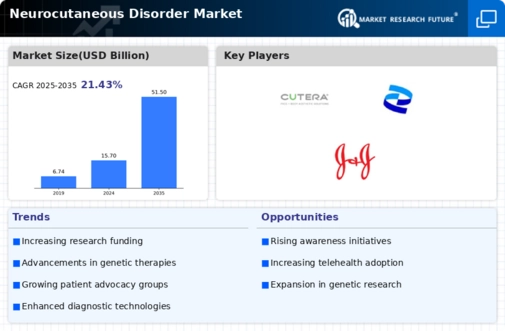Market Growth Projections
The Global Neurocutaneous Disorder Market Industry is projected to experience substantial growth, with estimates indicating a market value of 15.7 USD Billion in 2024 and a remarkable increase to 51.5 USD Billion by 2035. This growth trajectory reflects a compound annual growth rate (CAGR) of 11.38% from 2025 to 2035. Such projections underscore the increasing demand for effective treatments and diagnostic tools, driven by rising prevalence rates and advancements in medical technology.
Advancements in Genetic Research
Recent advancements in genetic research are significantly influencing the Global Neurocutaneous Disorder Market Industry. The identification of specific genetic mutations associated with various neurocutaneous disorders has opened avenues for targeted therapies and personalized medicine. For instance, the discovery of the TSC1 and TSC2 genes in Tuberous Sclerosis has led to the development of mTOR inhibitors, which are showing promise in clinical settings. As the understanding of these disorders deepens, the market is expected to grow, potentially reaching 51.5 USD Billion by 2035, driven by innovative treatment options.
Government Initiatives and Funding
Government initiatives aimed at improving healthcare access and funding for research into neurocutaneous disorders are playing a pivotal role in the Global Neurocutaneous Disorder Market Industry. Various countries are allocating resources to support research projects and clinical trials, which are essential for developing new therapies. For example, grants provided by national health institutes are facilitating studies on the efficacy of emerging treatments. Such support is likely to accelerate innovation and market growth, as evidenced by the anticipated increase in market value to 51.5 USD Billion by 2035.
Technological Innovations in Treatment
Technological innovations in treatment modalities are transforming the Global Neurocutaneous Disorder Market Industry. Advancements in surgical techniques, laser therapies, and pharmacological interventions are enhancing patient outcomes. For instance, minimally invasive surgical options are becoming more prevalent, allowing for effective removal of tumors associated with neurocutaneous disorders with reduced recovery times. As these technologies continue to evolve, they are expected to attract investment and drive market growth, contributing to the overall expansion of the industry.
Increased Awareness and Early Diagnosis
There is a growing awareness of neurocutaneous disorders among healthcare professionals and the general public, which is positively impacting the Global Neurocutaneous Disorder Market Industry. Early diagnosis is crucial for effective management and treatment of these conditions. Initiatives by health organizations to educate clinicians and patients about symptoms and available treatments are likely to enhance early detection rates. This trend may lead to an increased demand for diagnostic tools and therapies, thereby contributing to the market's projected CAGR of 11.38% from 2025 to 2035.
Rising Prevalence of Neurocutaneous Disorders
The Global Neurocutaneous Disorder Market Industry is witnessing a surge in prevalence rates of conditions such as Neurofibromatosis and Tuberous Sclerosis Complex. Current estimates suggest that Neurofibromatosis affects approximately 1 in 3,000 individuals globally. This increasing incidence is likely to drive demand for diagnostic and therapeutic solutions, contributing to the market's growth. With a projected market value of 15.7 USD Billion in 2024, the industry is poised for expansion as healthcare systems adapt to meet the needs of affected populations.













